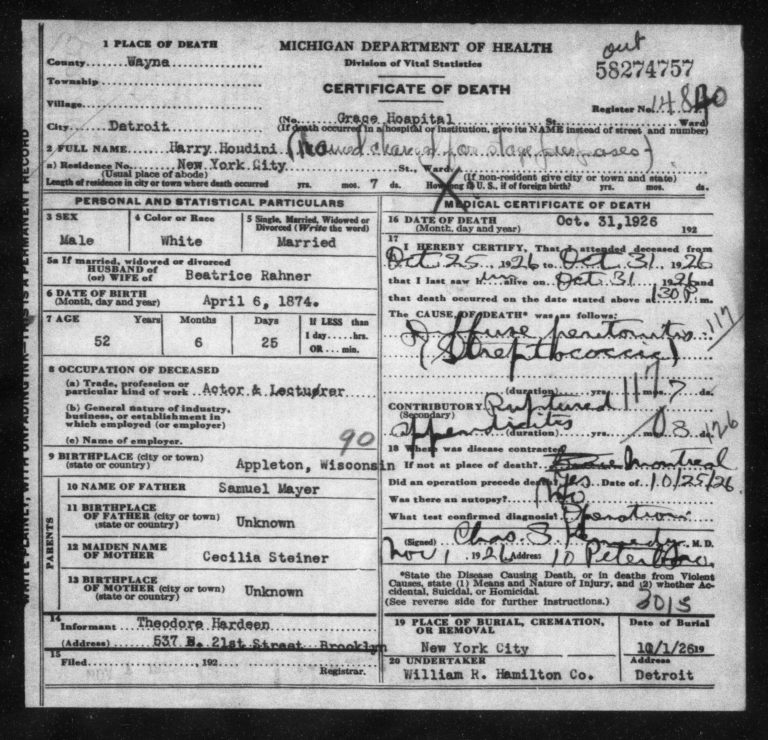Houdini in Detroit
- Discoveries in the Archives
Houdini’s Final Act
Harry Houdini walked briskly to the footlights of Detroit’s Garrick Theater on October 24, 1926, as “Pomp and Circumstance” played in the background. Smiling, he ripped off his sleeves to show there was nothing hidden and began his performance.
Beginning with a variety of vanishing acts, the famed magician made several silver coins and alarm clocks disappear. Then, he made an attractive woman vanish on stage and a flower bush appear in her place. Moments later, she shouted, “Here I am,” from the back of the theater and came running down the aisle. As Houdini attempted his next trick, pain from his midsection made him turn aside. With the help of his assistants, he struggled through the rest of the first act. As the curtain fell, he collapsed and was taken to the dressing room. Despite a 104-degree temperature, he returned to the stage and completed his two-and-a-half hour show. Then, he collapsed again.
At Grace Hospital in Detroit, doctors discovered the performer had a gangrenous appendix and peritonitis, an inflammation of the abdominal cavity wall. They removed the appendix, but the poison had already flowed through his bloodstream. Newspapers from across the country carried front-page updates on Houdini’s condition.
Escape Artist
Born Erich Weiss on March 24, 1874 in Budapest, Hungary, Harry Houdini moved with his family to Appleton, Wisconsin at age four. There, his father became the first rabbi in town. At thirteen, Houdini and his family moved to New York City, where his interest in magic grew. Houdini’s early shows consisted of card tricks and simple magic, such as producing a handkerchief from the flame of a candle and making a flower appear from the buttonhole of his jacket. He soon began performing a new form of entertainment called “challenge escape.”
Although Houdini wasn’t the first challenge-escape artist, he was the first to add suspense and anticipation to the act. Houdini prolonged his simple escapes by playing up the drama to the point where the crowd thought his death was imminent. In 1899, he headlined the largest chain of vaudeville theaters in the country and over the next few years toured overseas. Amazing escapes from straitjackets, handcuffs, leg irons and jail cells made him famous worldwide.
As thrilling as his escapes were, Houdini enhanced his legend by exaggerating stories of his feats. One of the best examples occurred in Detroit. The magician arrived in late November 1906 to perform for two weeks at the Temple Theater. Often performing public feats that drew attention to his show, Houdini decided to jump from the Belle Isle Bridge, bound with restraints, to promote his Detroit shows. According to Houdini, he leaped – handcuffed, chained and leg-ironed – into a small hole cut in the frozen river. Houdini claimed he was swept away by the current and stayed alive by breathing the air bubbles between the ice and water until he found the hole (The 1953 movie, Houdini, made the embellished version even more popular, depicting actor Tony Curtis swimming under the ice for eight suspense-filled minutes.). The jump from Belle Isle Bridge became Houdini’s most famous exploit.
However, the front page of the Detroit News on November 27, 1906 tells a different story. It reported that “tied by a lifeline a hundred and thirteen feet long, handcuffed…Houdini…leapt from the draw span of the Belle Isle Bridge at one o’clock this afternoon, freed himself while under water, then swam to a waiting lifeboat, passed over the unlocked and open cuffs and clambered aboard.” Though the river wasn’t frozen, the escape was still a remarkable feat in the cold November waters of the Detroit River.
Final Days
On Friday, October 22, 1926, a McGill University student approached Houdini before a Montreal show and challenged the magician’s boasts of being able to sustain punches to the stomach. Houdini accepted the challenge but was struck before he could tighten his muscles. In pain, Houdini performed his last four Montreal shows before traveling by train to Detroit and collapsing after his first show.
After a week in Grace Hospital, Houdini whispered to his brother, Theo, “I’m tired of fighting…guess this is going to get me.” Taking one last glance at his wife, Bess, he closed his eyes and died at 1:26 p.m. on Sunday, October 31, 1926.
Houdini’s career in magic and illusion is enough in itself to make him a legend. He also wrote, directed or acted in five movies, performed on Broadway, owned a movie-production company and was given one of the first stars on the Hollywood Walk of Fame. Seventy-four years after his death, his name is still synonymous with magic.
This article was originally published in the September/October 2000 issue of Michigan History Magazine.
